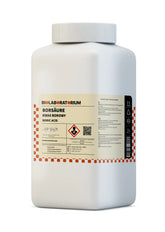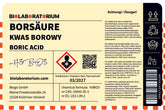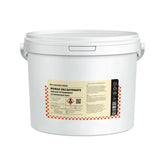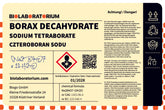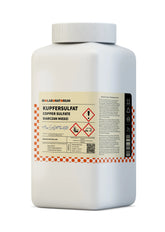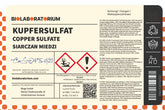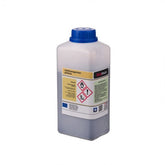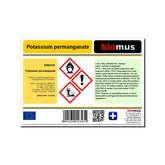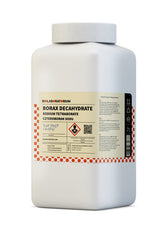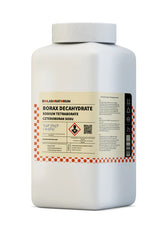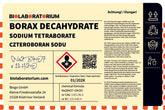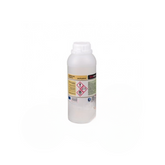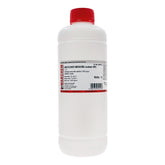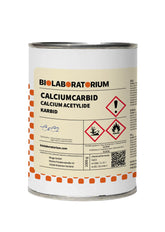Trichloroacetic acid (TCA): Chemical properties and safe laboratory applications
Trichloroacetic acid (TCA) is an important chemical compound with diverse applications in industry and research. In this blog post, we will take a closer look at the chemical properties of TCA and provide recommendations for safe handling in the laboratory.
Chemical Properties of Trichloroacetic Acid
Trichloroacetic acid, also known as trichloroethanoic acid, is a colorless, crystalline solid compound with the chemical formula CCl3COOH. It belongs to the group of carboxylic acids and is characterized by its strong acidity. With a pKa value of 0.66, TCA is one of the strongest organic acids.
Due to their high electronegativity, the chlorine atoms exhibit strong polarization of the carbon-chlorine bonds, leading to pronounced acidity. Trichloroacetic acid is well soluble in water and dissociates there completely into protons (H+) and trichloroacetate ions (CCl3COO-).
Besides its acidity, TCA is also a strong oxidizing agent. In the presence of water, trichloroacetic acid can oxidize other organic compounds and is itself broken down into carbon dioxide (CO2) and hydrochloric acid (HCl).
Applications of Trichloroacetic Acid
Due to its diverse chemical properties, trichloroacetic acid is used in numerous applications:
Analytical chemistry
TCA is used in analytical chemistry as a precipitating reagent to precipitate proteins from aqueous solutions. This allows proteins to be separated and concentrated from other components such as salts or nucleic acids. This method is used, for example, in sample preparation for protein analyses by gel electrophoresis or mass spectrometry.
Biochemistry and Molecular Biology
In biochemistry and molecular biology, trichloroacetic acid is used for the extraction and purification of nucleic acids such as DNA and RNA from cells or tissues. By precipitating the nucleic acids, they can be separated from proteins, lipids, and other cellular components.
Medical applications
In medicine, TCA is used as a caustic agent for the treatment of warts, genital warts, and other skin lesions. The acid causes coagulation and necrosis of the affected tissue, allowing the unwanted skin lesions to be removed.
Industrial applications
In industry, trichloroacetic acid is used as a cleaning agent, degreaser, and solvent. For example, it is used in the metal industry to remove oxide layers and corrosion residues. TCA can also be used in textile cleaning to remove grease stains.
Safe Handling of Trichloroacetic Acid in the Laboratory
When handling trichloroacetic acid in the laboratory, some safety aspects must be observed due to its hazardous nature:
Personal protective equipment
When handling TCA, wearing appropriate personal protective equipment (PPE) is essential. This includes at least a lab coat, chemical-resistant protective gloves, and safety goggles. Depending on the application, wearing respiratory protection may also be necessary.
Storage and Disposal
Trichloroacetic acid must be stored in tightly sealed, shatterproof containers and separated from other chemicals. The storage temperature should be as low as possible to avoid decomposition of the acid. Empty or unusable TCA containers must be disposed of as hazardous waste.
Waste Disposal
Aqueous solutions and residues of trichloroacetic acid must not be discharged into the drain or sewage system. They must be disposed of as hazardous waste through a certified disposal company.
First Aid Measures
In case of contact with trichloroacetic acid, first aid measures must be taken immediately. In case of skin contact, the affected area should be rinsed immediately with plenty of water. In case of eye contact, the eye must be rinsed for at least 15 minutes. If swallowed, medical help is required immediately.
By observing these safety instructions, the risks when handling trichloroacetic acid in the laboratory can be significantly reduced. Regular training of laboratory personnel is also important to ensure the safe handling of this and other chemicals.
Conclusion
Trichloroacetic acid is a versatile chemical compound with numerous applications in industry, research, and medicine. However, its strong acidity and oxidizing power require special precautions when handling. By adhering to safety standards and appropriate protective measures, TCA can be used safely and effectively in laboratories and production facilities.

